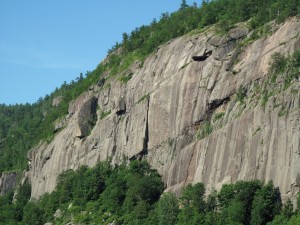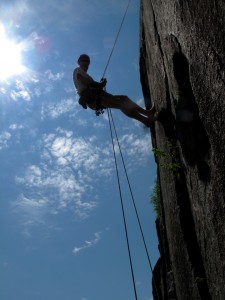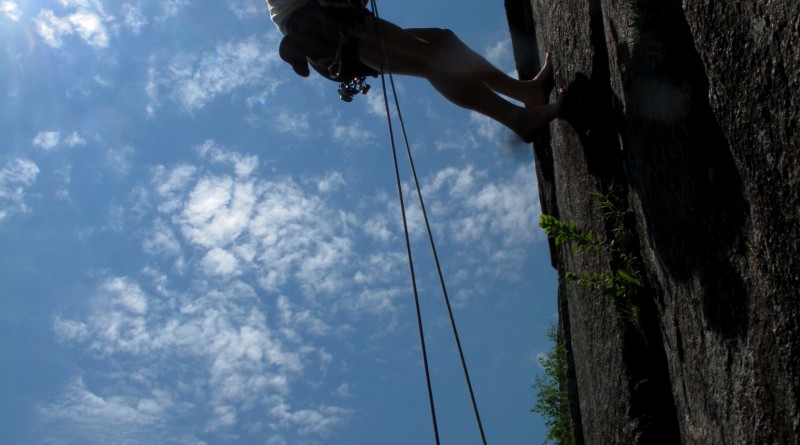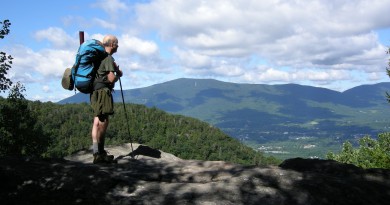The East’s Big Walls | A Climber’s Guide to the Northeast’s Tallest Cliffs
Ask any climber the first word that pops into his or her head when you mention “big wall climbing,” and they’ll almost invariably respond with just one word: Yosemite. Look up the phrase “big wall climbing” in the dictionary, and you’ll probably find no words at all, just a picture of Yosemite’s El Cap. For decades it defined—and in many respects, continues to define—the climbing genre.

Traditionally, big wall climbing involved very long (1,000-plus feet) routes, on consistently steep rock, with sustained difficulty (almost certainly requiring aid climbing techniques), and typically requiring haul bags and a portaledge (to spend one or more nights hanging from the wall).
>>See related story, What’s New and Improved in Big Wall Gear
Times have changed. Big wall climbing is no longer epitomized by one single place, nor can it be described as a concrete style with definitive boundaries. Routes that once required aid are now being climbed free. Climbs that once required spending the night partway up a cliff are being climbed in a single day (or less). “Big wall” terms and techniques are being applied to other venues of the climbing life. Larger alpine objectives such as the Trango Towers in Pakistan or the Torre Group in Patagonia can be approached in big wall style. Meanwhile, smaller cliffs that might not otherwise fit the strict definition of big wall climbing are often described as having a “big wall section”—a stretch of cliff that’s steeper, taller, more sustained, than the rest.
What constitutes “a big wall” is becoming more a matter of perspective. And by that measure, the Northeast has no shortage of its own big walls for climbers. These are not merely training grounds in preparation for “real” big wall climbing. They are worthwhile objectives in their own right.
Here’s a sampling of the Northeast’s best big walls (roughly ordered from west to east), with classic routes on each that’ll get you off of terra firma and into the vertical realm, with plenty of air beneath your heels.
Wallface, New York
Located roughly six miles from the nearest trailhead, mighty Wallface—in the heart of the Adirondack High Peaks—is one of the largest wilderness rock faces in the eastern United States, towering more than 600 feet above Indian Pass. Legendary climbers, such as former American Alpine Club president John Case and German Fritz Wiessner left an indelible mark here. Their early routes remain popular today, decades after they were first climbed. But the quintessential Wallface climb remains The Diagonal, a moderate route that threads a line up one of the tallest sections of the cliff, including up a giant, leaning ramp that is the route’s namesake. For an even more authentic big wall experience, set your sights on Mental Blocks. Most climbers tackle it with a combination of moderate free and aid climbing, though very strong climbers have successfully climbed it with some pretty stout free climbing. It is steep and exposed, and even includes a short pendulum from one crack system to the next.

Poke-O-Moonshine, New York
Stunning Poke-O-Moonshine soars above Interstate 87 in the eastern Adirondacks, just four miles (as the crow flies) from the shores of Lake Champlain. Known for its striking test piece ice routes, such as Positive Thinking, this 500-foot cliff is equally commendable for its high-quality rock. From a long list of stellar climbs, set your sights on Gamesmanship, the “must do” rock route, if you have to choose only one. It wakes you up early, with the crux right off the ground. After that, expect plenty of pure crack climbing on impeccable granite.
Cannon Cliff, New Hampshire
Like Poke-O-Moonshine, massive Cannon Cliff stares down on a major highway—Interstate 93 in Franconia Notch. More than a mile wide, and 1,000 feet tall in places, it is the granddaddy of Northeast big walls, amazing in its sheer size and scale. It’s a committing undertaking for any climber. Plus, the granite is continually exfoliating, shedding rock (as evidenced by the monumental talus field at the cliff’s base, not to mention the iconic Old Man of the Mountain, which collapsed in 2003). Climbers of all abilities flock (relatively speaking) to one route in particular: the Whitney-Gilman Ridge. Call it a ridge or a prow, or a prominent arête. One thing is certain: the route’s exposed position offers airy and thrilling moderate climbing up what some have called New England’s only genuine big wall.
Cathedral Ledge, New Hampshire
North Conway’s Cathedral Ledge is to Cannon what Poke-O-Moonshine is to Wallface—a bit shorter (but still no slouch), more accessible, and with a high concentration of great routes. The classic route is Recompense, a tough moderate that ascends The Prow, the tallest section of the cliff. Newer climbers will want to focus instead on Thin Air, while stronger climbers will want to tackle The Prow, a hard route that ascends the nose of the main cliff feature it’s named after.
Parc des Grands-Jardins, Québec
One of the flagships of Québec’s provincial park system, the Parc des Grands-Jardins is host to not one big wall but several, spread across three peaks—The Dome, Mont Gros Bras, and Mont de l’Ours. Standing in the bottom of dramatic valleys, you’re surrounded by a Québecois Yosemite, with steep Laurentian mountains and bare rock faces everywhere you look. Classic routes such as L’Onglee on The Dome, Hals Und Bein Bruch on Mont Gros Bras, and La Directe on Mont de l’Ours offer four to six pitches of easy moderate climbing. Located north-northeast of Québec City and north of the St. Lawrence, it’s not around the corner, but the drive is worth it.



